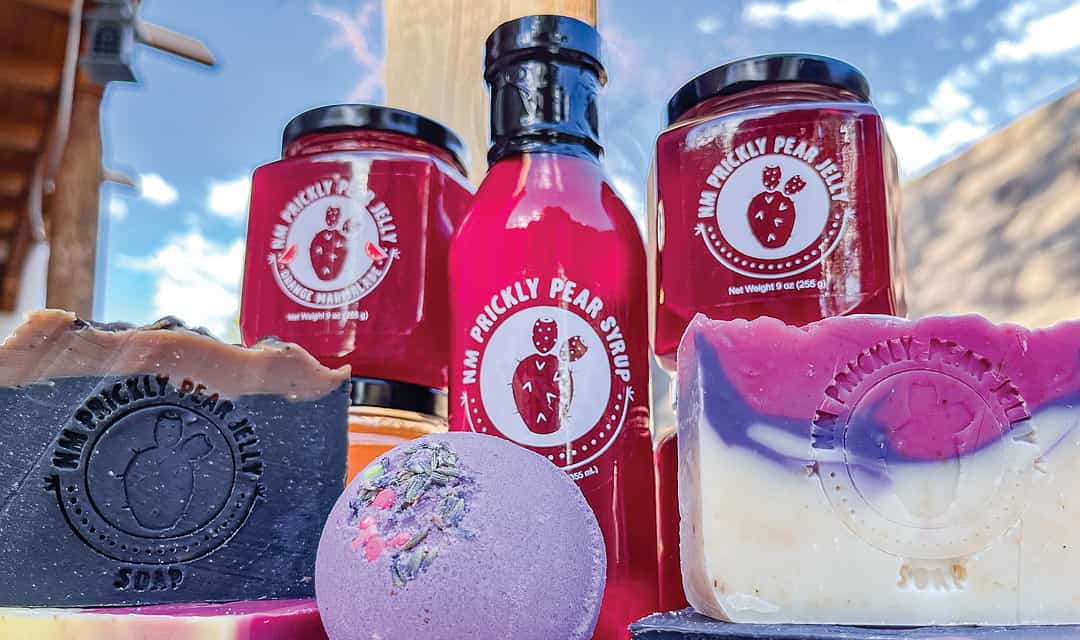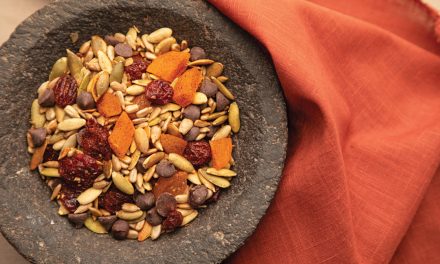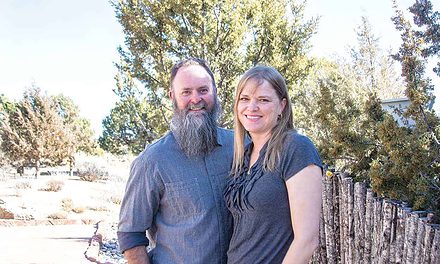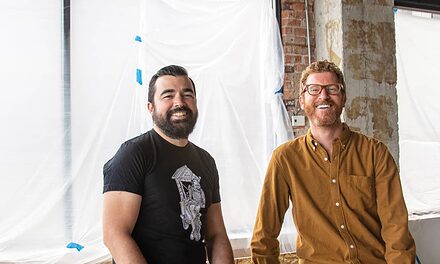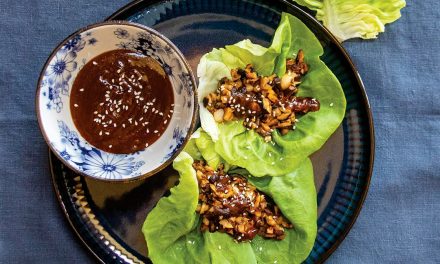LOCAL HERO: FOOD ARTISAN
An Interview with Phyllis Riboni-Hustead, Owner
Photos by Stephanie Cameron

A family business: Cody Hustead, Uvaldo Riboni, Roger Hustead, Phyllis Riboni-Hustead, Lucky Hustead, and Clay Chancellor.
NM Prickly Pear Jelly is a family operation with Albuquerque roots that promotes buying local whenever possible to support our communities. Their prickly pears are grown and harvested in the East Mountains of Albuquerque. It is the nutrient-rich soil of the surrounding mountains that provides the fruit with a unique flavor and beautiful color. The pears are then processed in the commercial kitchen at the South Valley Economic Development Center (SVEDC). NM Prickly Pear Jelly’s syrups and jams can be found at Albuquerque’s Rail Yards Market, Whole Foods, and many other places. A perfect day off is hard to imagine—whether at the farm or in the kitchen, there’s always work to be done—but if it happened, Prickly Pear Honey and their newest jam, Ghostly Prickly Pear, would be on the menu.
What’s the origin story for your business?
Here in Albuquerque, year after year, we used to see prickly pears all over the ground, and we always wondered why no one would want them. Finally, my family bought me a recipe book with a prickly pear jelly recipe. It took some time to get the recipe right for our tastes, and it took off with friends and family. We sent it to relatives and acquaintances all over the country. One family member suggested we go into the prickly pear jam business. Truth is, I never thought it would have gone this far.
How do you farm prickly pears, and what are some of the challenges? Are all your prickly pears of the same variety?
The pears are easy to farm. It only takes a little water. The biggest challenge is the wild animals who like prickly pears as much as we do! Prickly pear is naturally organic; there is no need to spray for insects. However, from time to time, we get black widow spiders that probably feel safe in the cactus.
As far as variety goes, I like the ones that just grow wild in the mountains; they give large fruit with a beautiful color.
You describe yourself as a zero-waste company; what does that mean, and what led you to focus on reducing waste?
We are determined to keep the beauty of the East Mountains by recycling all waste produced during production. Therefore, all seeds and skins are dried and used to make our prickly pear soap and bath bombs. Any leftovers from this process are returned to the soil to fertilize the following year’s crop.

Phyllis Riboni-Hustead of NM Prickly Pear Jelly processing tunas at the South Valley Economic Development Center, and NM Prickly Pear products.
Talk about your partnerships with other food artisans. How have those come about?
We have been lucky to find great partners in the following food artisans:
- Bristol Doughnut Co.: We started our businesses simultaneously, cooking at the SVEDC and hoping for the same dream. Sarah featured a prickly pear doughnut of the month. It was such a hit that it is permanently on the shop’s menu as its Prickly Pear brioche doughnut.
- Tractor Brewing Co.: Prickly Pear Cider. This is to die for.
- Bar X Brand jerky: Our juice is used to make their margarita–dried pineapple jerky.
- El Patron: Their Montgomery restaurant uses our syrup for their prickly pear drinks like margaritas.
- Fat City Eats Treats and Sweets: They make great pastries with our jams.
What are your favorite ways to use prickly pear jelly or syrup at home?
At home, we always have something prickly pear; this helps us check the quality of our product. From pancakes, barbecue, glazes, drinks, salad dressings, and dips, the prickly pear salsa is the best!
In Mexico, prickly pear paddles, or nopales, are almost as widely used as their fruits. What do you think limits their market in the United States? Do you ever cook with them?
Since Mexico is the largest producer of a dedicated crop of nopales, it is readily available and woven into their traditions. Even though Mom was born in Texas, she used to fry these with tomato sauce and red chile flakes for us.
What does it take to get your products onto the shelves at Whole Foods?
Lots of work, persistence, and patience. Everything there works in cycles, so timing is everything. The people at Whole Foods are fantastic to work with, so it is well worth the wait. They genuinely believe in small businesses and our products.
When you talk about community, how do you define yours?
Our community comprises all the people we have met on this journey. We are still friends with the people we met from the day we first entered the SVEDC’s commercial kitchen as well as those we have met at the Rail Yards Market on the weekends. We have watched not only our businesses grow together but also our kids.
What does sustainability mean to you?
To continually grow your business while leaving the planet in better shape than you found it.
505-250-5651, nmpricklypear.com

